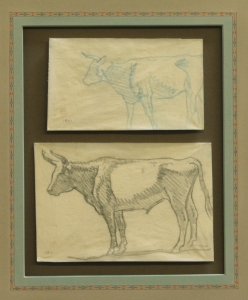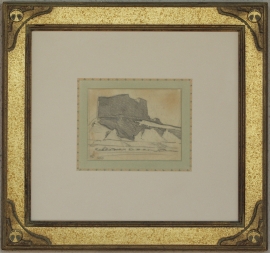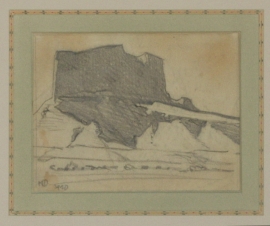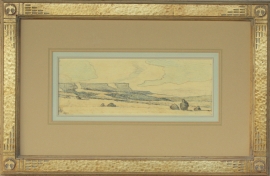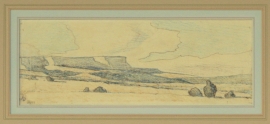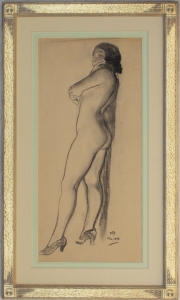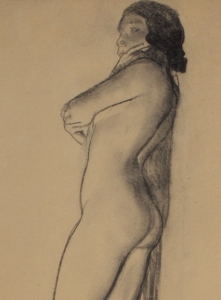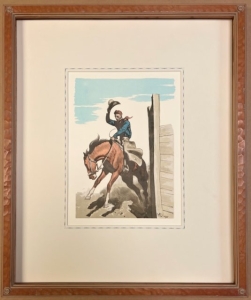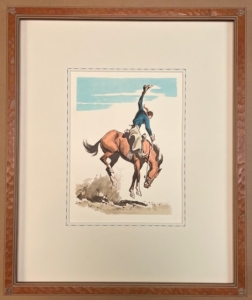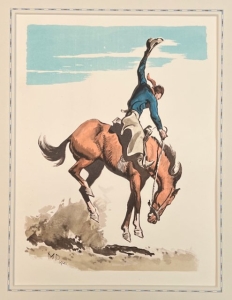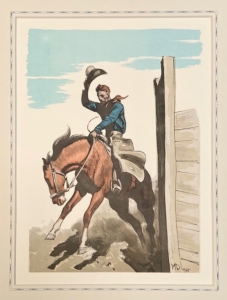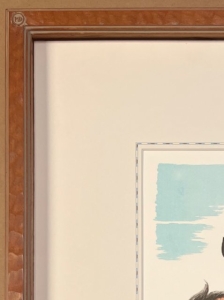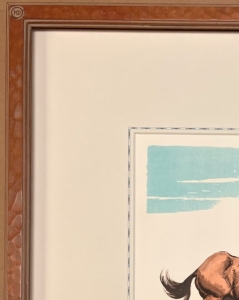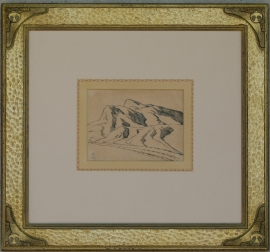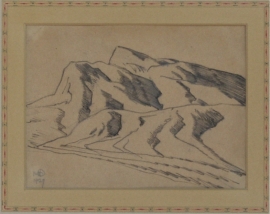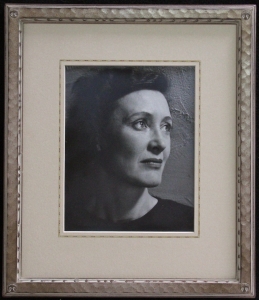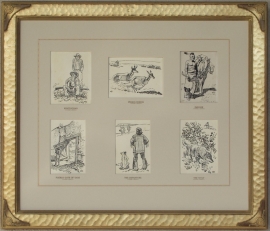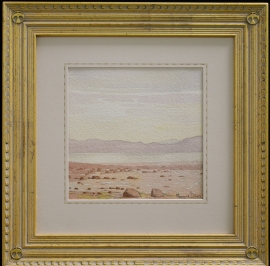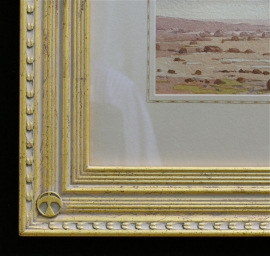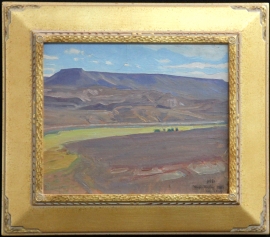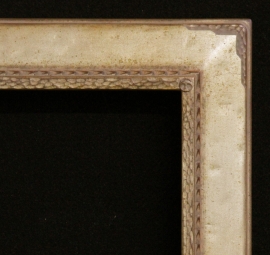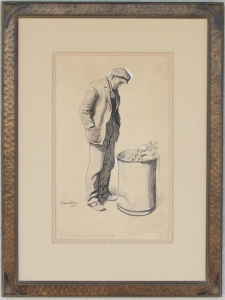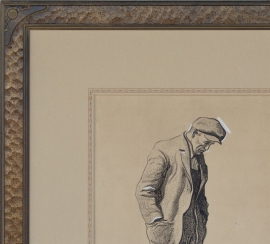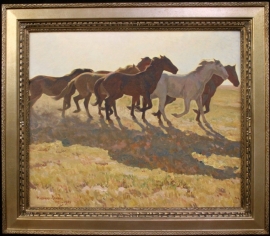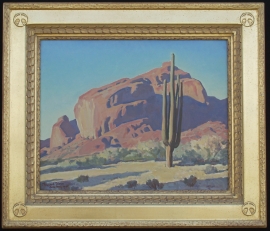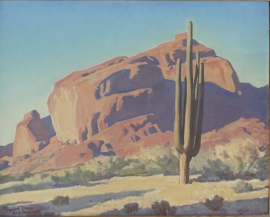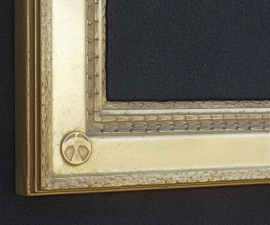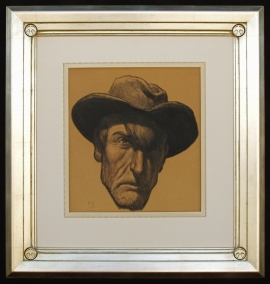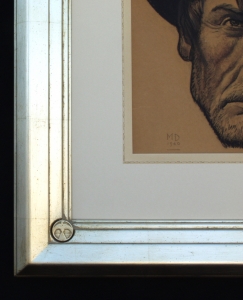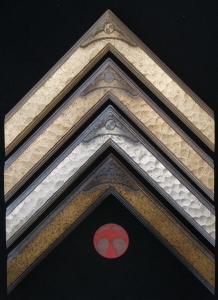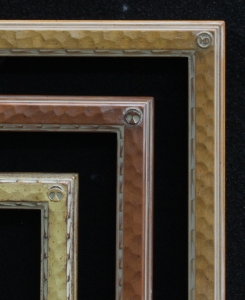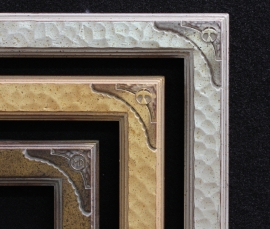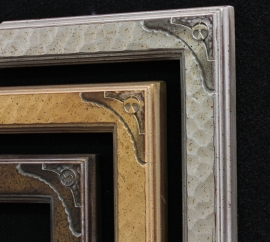Maynard Dixon
Original Fine Art and Custom Design Signature
Frames for Fine Art Collectors and Dealers
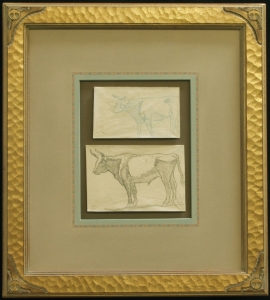
Study of Steers, Refuge Ranch, Utah 1921, $7,900.00, Two drawings done on the Dixon Family Ranch, "Refuge", Madera County, California, 1921. Acquired by Donald Hagerty, Dixon authority, directly from Edith Hamlin Dixon. Drawing sizes are 3.25 x 5.5 inches and 4.25 x 6.25 inches. Custom Dixon signature frame with Thunderbird logo. French matting with hand dyed mat, archival standards. Frame size is 18.5 x x12.5.
Ansel Adams once commented that for Maynard Dixon, “the West was uncrowded, unlittered, unorganized and free.” Adams might have added that Dixon would allow no fences to surround him, imaginary or real. Ultimately Dixon argued that American painting could best work its influence on the lives and thoughts of people when painters based their work upon native material and their native reaction to it. Maynard Dixon was a regionalist long before the term arrived, with a confirmed belief in the vitality of America. His region was the arid landscape of southern California, Nevada, Utah, Arizona, and New Mexico.
Although he was geographically isolated from the mainstream, Maynard Dixon should be regarded as a pivotal connection between late nineteenth-century and contemporary American art. His work opens the way for the sparse rock-, cloud-, and desert-scapes vocabulary developed by a number of artists, including Georgia 0’Keeffe, Conrad Buff, Helen Frankenthaler, and Ed Mell.
Dixon’s long, productive life was, in itself, a work of art. From the beginning Dixon was different: an authentic, iconoclastic, self-created individual. Born in Fresno, California, in 1875, Dixon ended his formal art training in early 1893, after three miserable months at San Francisco’s Mark Hopkins Institute of Art. Most of his American contemporaries made an obligatory pilgrimage to Paris for study; Maynard did not go. Instead he became an active and outspoken, if sometimes ambivalent, participant in California’s cultural life.
By the middle 1890s, in an era acknowledged as the Golden Age of Illustration, he was one of the country’s foremost purveyors of nostalgic, Old West images. Hundreds of his pictures appeared in leading newspapers, magazines, and in books by such authors as Jack London, John Muir, O. Henry, Mary Austin, Eugene Manlove Rhodes, and Clarence Mulford (of the Hopalong Cassidy series).
After 1912, when he concluded he could no longer portray the West in “false” terms, Dixon devoted increasing attention to easel and mural painting, experimenting with impressionism, post-impressionism, and large-scale mural decoration, while still pursuing a career in commercial art, particularly poster design. In 1921, supported and encouraged by his second wife, photographer Dorothea Lange, Dixon downplayed his commercial art career. He was interested in modern art techniques, but he rejected any assessment of a “one best way,” and scorned experimental painting borrowed from European movements. The “narrow orthodoxy of modernism, where self-expression is used as an alibi for idiocy” angered him.
Maynard Dixon was also, for much of his life, a solitary desert pilgrim. From 1900 to his death in 1946, Dixon periodically roamed the West’s plains, mesas, and deserts on foot, horseback, buckboard-even by automobile-drawing, painting, and writing, pursuing a transcendent awareness of the region’s spirit. These long, often solitary excursions into lands “where no one went,” were prompted by intense personal and philosophic examinations. “Quantum Sufficet,” a verse he wrote in 1921, gives a vivid picture of its author:
O, I am Maynard Dixon, And I live out here, alone With pencil and pen and paint-brush And a camp stool for my throne King of the desert country Holding a magic key To the world’s magnificent treasure None can unlock but me! At times come terrible moments When desire fills full my soul, And women and wine and cities Seem a compelling goal; But I wake with a start to my desert And its lovely vistas unfurled,– I’d rather be Maynard Dixon, Than anyone else in the world!
Through long and sympathetic observation, he learned how plains rise and fall as they flow toward the horizon and how the architecture of mesa and butte marches rhythmically over the landscape into the infinite freedom of a deep blue sky. Whether Dixon painted in the field or studio, he portrayed the West in its own colors, its own light, its own forms, shaping his work with an instinctive feeling for landscape elements, demanding a standard beyond objectivity. Maynard Dixon had something to say. Where many have looked, few have seen. Among these few is Maynard Dixon.
From “Desert Dreams: The Art and Life of Maynard Dixon” by Donald J. Hagerty
For an insight into the life of the artist, click on Maynard Dixon
Some frames shown are prototypes, others were custom designed for clients.
The four chevron corners are the standard used.
Artwork is for display only
Please contact for custom frame quote.


